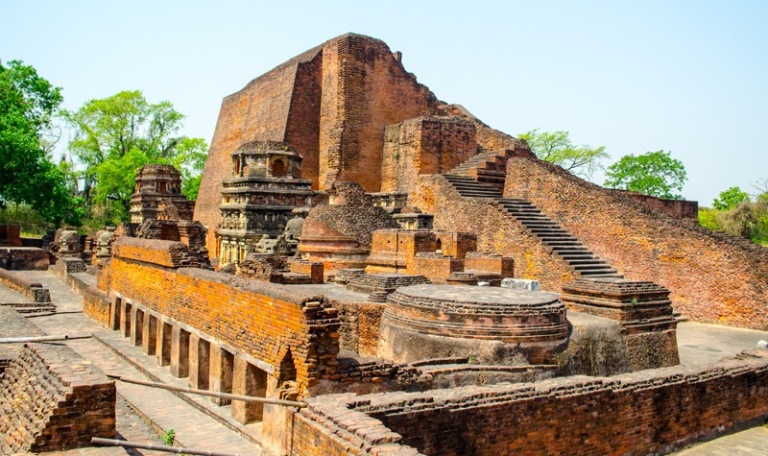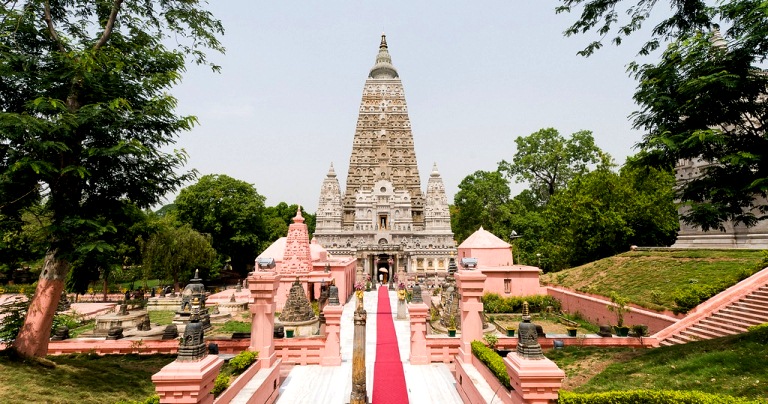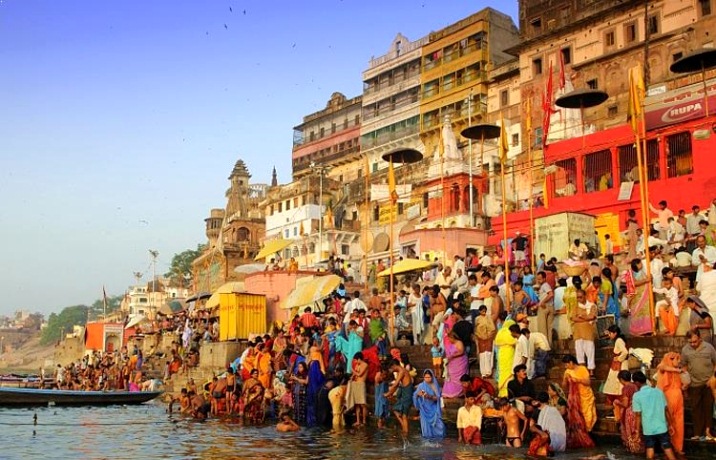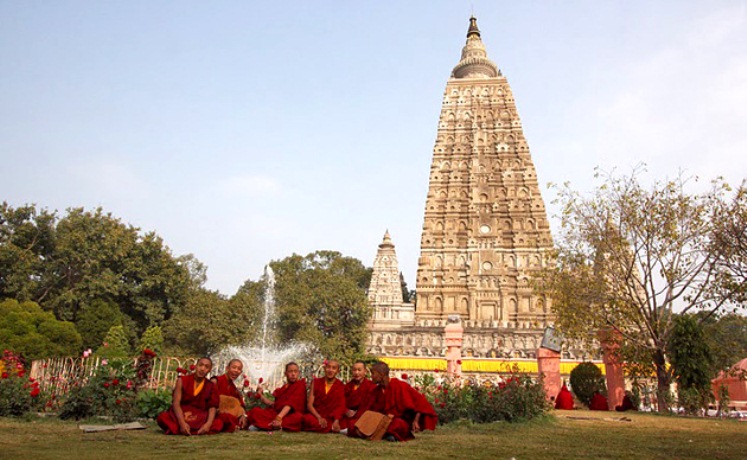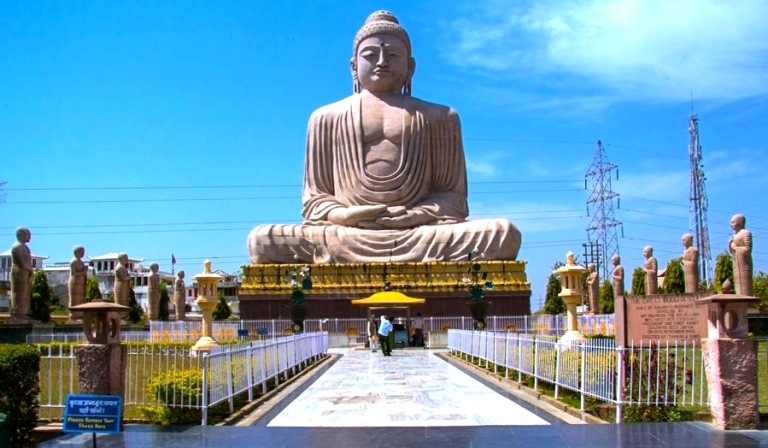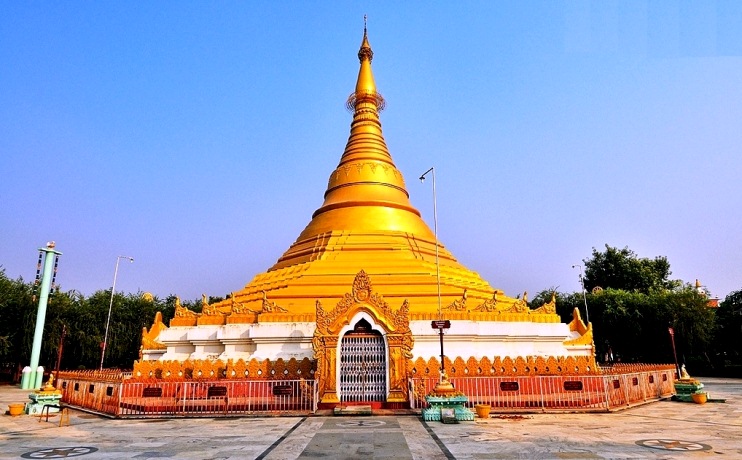
OVERVIEW- Buddhism is one of the most primitive and the largest religions of the world. Buddhist Trail Tour is a peaceful discovery of incredible experiences in the land of Buddha. The tour starts iconic cities of India, Delhi and Agra trailing to Sarnath near Varanasi where Lord Buddha gave his first sermon of Middle Path to his first five followers. From there moving to the epicenter of Buddhism, the journey continues towards Rajgir, the ancient Magadha capital Rajagriha where Lord Buddha gave many discourses. Thereon, the tour moves towards Kushinagar, the site of his final par nirvana. The journey brings the rapturous bliss for a tourist or pilgrim who visits the contrasting site of the lord's birth in Lumbini. The last destination in the Buddhist trail is Shravasti, where Lord Buddha spent his 24 monsoon retreats and gave many enlightening discourses.
DELHI- New Delhi, capital of India is a mix of the ancient and modern architecture. This 3rd largest city of India unwinds a picture rich with culture, architecture, and human diversity. Divided in two parts, Old Delhi & New Delhi, the city is a travel hub of Northern India and exerts a beguiling charm on visitors.
AGRA- The Land of culture and heritage. Agra is the city of the inimitable Taj Mahal. Agra is famous for its marble inlay work, leather goods, brasswares, finely worked precious and semi-precious stone jewellery and ornate zari embroidery.
VARANASI- It is one of the oldest living cities in the world. It probably derives from the two rivers that flank the city, the Varuna to the north and the Asi to the south. Many still use the anglicized forms of Banaras or Benares, while pilgrims refer to Kashi. The city of Banaras is situated on the west bank of the holiest of all Indian rivers, the Ganga or Ganges. The relationship between the sacred river and the city is the essence of Varanasi - 'the land of sacred light'.
SARNATH- An ancient city, dating back to 528 BC, Sarnath is believed to be the first place where Lord Buddha started preaching and laid the foundation of Buddhism. It is one of the Buddhism's pilgrimage centers of India. Post attaining enlightenment, Buddha came to Sarnath where he gave his first sermon.
BODHGAYA- Gaya is the most symbolic city of Bihar. From being the birthplace of Buddhism to sharing deep bond with Hinduism and Jainism it is one of the major pilgrimage sites for Hindus and Buddhists. Its natural surroundings, narrow by lanes and its age old buildings make it special. Gaya is important for Buddhists as Buddha preached the Fire Sermon at Brahmayoni Hill, which was earlier called Gayasisa.
RAJGIR- Rajgir is town where the air that surrounds its beautiful sceneries carries hints of spirituality and vibrant hues of history with links with both Buddhism and Jainism. Set in a green valley and surrounded by rocky hills, Rajgir is a spiritual town with natural serenity amongst the dense forests, mysterious caves and springs. Both Lord Buddha and Lord Mahavir have said to spent time here giving Rajgir a huge spiritual and religious importance.
NALANDA- Nalanda is located in the eastern Indian state of Bihar. It is well known as the ancient centre of learning which has the remains of the great Nalanda University and several monasteries and temples. Both Lord Buddha and Mahavira visited this place and it remained a renowned learning centre till 12th century.
PATNA- Prospering along the southern banks of river Ganges and set in the conglomerated backdrop of rich ancient heritage and a glorious historical past, Patna boasts of a dominating presence in history and enjoys the distinction of being one of the oldest cities in the world. Originally called as Pataliputra, Patna is currently a hot-bed for the culminating political fortunes.
VAISHALI- Vaishali is deemed to be the embrace of people of two main religions of India which are Buddhism and Jainism. This place is supposed to be the oldest republic of the world. Vaishali is the birth place of Lord Mahavira, Lord Buddha preached his last sermon here and Emperor Ashoka erected a lion column to commemorate the occasion.
KUSHINAGAR- Nestled in the heart of Uttar Pradesh; Kushinagar is one of the ancient towns that attract people from all over for its beautiful Stupas and Temples. Kushinagar is a place where Lord Buddha attained Nirvana. It is famous for numerous monasteries and stupas dating back years ago are almost in relics now.
LUMBINI- Lumbini is one of the holiest places of one of the world's great religions, and its remains contain important evidence about the nature of Buddhist pilgrimage centers from as early as the 3rd century BC. Lumbini, situated in the southern Nepal is a sacred site as Lord Buddha was born here.
KAPILAVASTU- The little village of Piprahwa is a very important Buddhist pilgrimage since Lord Buddha had spent his first twenty-nine years of life in this region.
SHRAVASTI- Shravasti is the Mystical Abode of Lord Buddha for 25 Monsoons. It is a well know place as it happens to be a very famous Buddhist pilgrimage site. This place is termed to be the ancient capital of the Koshal kingdom. It also houses the monastery where Lord Buddha stayed for several years.
LUCKNOW- The capital and the largest city of Uttar Pradesh, Lucknow, situated on the banks of river Gomti. From a slice of rich colonial history to modernized museums, the 'City of Nawabs' beautifully brings together the opulence of a glittering past and the simplicity of a modern city.
Tour Destination: Delhi - Agra - Varanasi - Sarnath - Varanasi - Bodhgaya - Patna - Vaishali - Kushinagar - Lumbini - Sravasti - Lucknow - Delhi
Travel Duration: 10 Nights/11 Days
DAY 1: DELHI
Arrive in Delhi and later transfer to the hotel. Later enjoy full day city tour of Old Delhi & New Delhi visiting
RED FORT- This is a magnificent fort with beautiful artwork of red sandstone on the banks of river Yamuna. It is a huge complex of gardens and pavilions and marble palaces.
JAMA MASJID- This is the largest mosque in India, located opposite to the Red Fort, it was again the great Mughal Emperor Shah Jahan behind this architectural masterpiece.
RAJ GHAT- Built on the banks of the legendary Yamuna, which flows past New Delhi, Raj Ghat-the last resting place of Mahatma Gandhi, the father of the nation.
INDIA GATE- Built as a memorial to commemorate the 70,000 India soldiers killed in World War I, India Gate was designed by Sir Edwin Lutyens and completed in 1931. The green, velvety lawns at India Gate, particularly, are a popular evening and holiday rendezvous for young and old alike.
PRESIDENT'S HOUSE- New Delhi, centers around the Rashtrapati Bhawan. It is architecturally a very impressive building standing at a height, flowing down as it were to India Gate.
HUMAYUN'S TOMB- The emperor's grieving widow, Haji Begum, built Humayun's Tomb the first mature example of Mughal architecture in India, in 1565 AD.
LAXMI NARAYAN TEMPLE- Also called the Birla Mandir it was built in 1938; the temple is an ideal introduction to some of the gods of the India pantheon.
LOTUS TEMPLE- The Bahai's Temple, is shaped like a lotus. It is an eye-catching edifice worth exploring. Built by the Bahai's community, it offers the visitor a serenity that pervades the temple and its artistic design.
QUTAB MINAR- It is among the tallest and famous towers in the world. Qutab Minar is famed as the highest brick minaret of the world, located amidst the lush greens of South Delhi.
Overnight at Hotel.
DAY 2: DELHI - AGRA
After breakfast at hotel, drive from Delhi towards Agra. Transfer to hotel. Post lunch visit Agra viewing
TAJ MAHAL- It is the most beautiful monument in Agra. The beauty and grandeur of the Taj Mahal has made it one of the Seven Wonders of the World. Built by Shah Jahan in memory of his wife-Mumtaz Mahal, the Taj Mahal is regarded as one of the most beautiful monuments in the world. A beautiful gift from a Mughal emperor to his deceased wife, the Taj Mahal is a symbol of love and beauty.
Overnight at Hotel.
DAY 3: AGRA - VARANASI
After breakfast at the hotel, visit Agra viewing
AGRA FORT- Built in red sandstone, this huge fortress on the bank of the Yamuna. The fort house has many beautiful palaces and mansions, which include Jahangiri Mahal, Khass Mahal, Diwan-i-Khass and Diwan-i-Aam.
ITMAD-UD-DAULA TOMB- Also known as Baby Taj, this tomb is a daughter's tribute to her father. It was built in 1628 by Nurjahan in memory of her father Mirza Ghiyas Beg.
Later in the evening transfer to Agra Railway Station to catch train to Varanasi situated on the west bank of the holiest of all Indian rivers, the Ganga or Ganges.
Overnight in Train.
DAY 4: VARANASI - SARNATH - VARANASI
Today morning go on an excursion to the City of Enlightenment- Sarnath. Located 10kms East of Varanasi close to the confluence of rivers Ganges and Varuna, Sarnath is one of the major Buddhist pilgrimage sites in the world.
CHAUKANDI STUPA- The stupa is regarded as one of the most divine and important monuments of the Buddhist culture. This stupa has been built on the exact spot where the great Lord Buddha first met his five ascetics- to whom he later went on to preach his first teachings.
ASHOKA PILLAR- The national emblem of India and a mark of Emperor Ashoka's visit to Sarnath, the Ashoka Pillar crafted out of stone is an impressive structure with four lions at the top.
THAI TEMPLE- The temple displays the Thai style of architecture. The temple is set amongst beautiful gardens and is managed by Thai Buddhist Monks offering calm and peaceful surroundings.
TIBETAN TEMPLE- This Buddhist shrine has been decorated with Thangksa, which are Tibetan Buddhist paintings. The temple features a statue of Shakyamuni, the Buddha.
Later return back to Varanasi and spend evening view Aarti ceremony on the Ghats.
Overnight at Hotel.
DAY 5: VARANASI
After breakfast, visit Varanasi viewing
KASHI VISHWANATH TEMPLE- Kashi Vishwanath, a manifestation of Lord Shiva, is the patron deity of Varanasi. The idol is a jyotirlinga, one of the 12 jyotirlingas in India. The Kashi Vishwanath temple has been built and re-built several times over the past few centuries. The present temple was built in the 18th century by Rani Ahalyabai Holkar of Indore after Mughal emperor Aurangzeb destroyed the previous temple and built a mosque at the site (now adjacent to it). The temple gets its name from Kashi, which is another name for Varanasi.
BANARAS HINDU UNIVERSITY- Banaras Hindu University is one of the largest universities in the world and a prime attraction in Varanasi. It was founded by Pandit Mohan Malviya in 1916 and is internationally reputed.
ASSI GHAT- Assi Ghat is the southern most ghat . It is located at the confluence of Ganga and Assi rivers. In the evenings, there is an aarti at Assi Ghat which attracts many tourists. Pilgrims bathe in the waters at the ghat before paying homage to Lord Shiva. It is the best place to witness Hindu culture and traditions as well as a beautiful sunrise.
DASHASHWAMEDH GHAT- Dashashwamedh Ghat is one of the oldest and most important ghats in Varanasi. In the early 16th century when the Marathas were ruling over the region, th3ey built several ghat sin Varanasi that lined the holy river Ganga.
Overnight at Hotel.
DAY 6: VARANASI - BODHGAYA
Today drive to Bodhgaya. Transfer to the hotel. Later visit the holy city of Gaya.
MAHABODHI TEMPLE- The Mahabodhi temple is also called as the "Great Awakening Temple". It is among one of the World Heritage Sites. It is a Buddhist temple in Bodh Gaya, which marks the location where the Buddha, is said to have attained enlightenment. Mahabodhi temple is a historical place at which the Enlightenment of Gautam Buddha took place which later on became a place of pilgrimage.
BODHI TREE- The Bodhi Tree, is perhaps the most prominent and respected sacred places in Buddhism because of the rich historical significance attached to it. It is under this tree that Prince Siddhartha Gautama, the spiritual teacher who later became to be known as the Buddha, attained enlightenment. It is believed that Prince Siddhartha had to sit and meditate under this tree for seven days. Later on, a shrine known as Animisalocana Cetiya was erected on the spot where he had sat down. A small temple was also built near the Bodhi tree in the 7th century.
GREAT BUDDHA STATUE- This statue of Lord Buddha is the tallest in India and was instated by the XIV Dalai Lama in 1989. It is a meditating Buddha resting on a giant lotus, constructed using intricately carved sandstone and red granite.
THAI MONESTRY- Well known for its curved roof covered with exquisite tiles of gold, the Thai Monastery houses a bronze statue of Buddha and another recently erected 25m high statue in the garden.
ROYAL BHUTAN MONESTRY- The Royal Bhutan Monastery has been named so, as it was built by the King of Bhutan as a dedication to Lord Buddha. Clay carvings are seen on the interior walls of the monastery that depict different aspects of the Buddhist culture.
Overnight at Hotel.
DAY 7: BODHGAYA - RAJGIR - NALANDA - BODHGAYA
Today morning go on an excursion to Rajgir and Nalanda.
JAPANESE PEACE STUPA- Also known as the Vishwa Shanti Stupa, this pillar is situated atop the Gridhakuta hill at an altitude of 400m. It was built as a symbol of world peace by the Japanese. This marble pillar also showcases four golden statues of Buddha depicting different stages of his life - birth, enlightenment, preaching and death. This location can be accessed by an aerial ropeway.
VULTURE'S PEAK- This was the place where the Lord Buddha set in motion his second wheel of Law and for three months every year during the rainy season, preached many inspiring sermons to his disciples. The Buddha Sangha of Japan has constructed a massive modern stupa, the Shanti Stupa (Peace Pagoda), at the top of the hill in commemoration.
BAMBOO GROVE- King Bimbisara donated the Bamboo Grove, Veluvana to Buddha for his residence. Today, it is a park with admiring sights of bamboos, flowers and a large pond with Buddha's image in the centre.
Further continue your drive to the beautiful city of Nalanda visiting
NALANDA UNIVERSITY- This University is one of the ancient heritage marvels of India that shaped the country's identity as the giver of the knowledge. Spread over an area of 14 hectares, the ruins here feature splendid temples and monasteries built by the patron kings.
NALANDA MUSEUM- Established in 1971, Nalanda Museum houses many ancient antiquities excavated from Nalanda University ruins and also at Rajgir. The antiques here feature many Buddhist and Hindu bronzes, a number of ancient Buddhist manuscripts, coins, pottery and inscriptions of Maurya and Gupta period.
SURYA MANDIR- Located near Nalanda University, Surya Mandir is dedicated to the Sun God and features a number of Hindu and Buddhist idols.
HUIEN TSANG MEMORIAL HALL- This memorial hall is dedicated to the historic Chinese traveller who came who left his home country in pursuit of Buddha and Buddhism to India in the 5th century AD and stayed in Nalanda for 12 years as a student. Also, he served the university as a teacher and studied the social and political conditions in the country. The memorial hall was built in his memory.
In the evening return back to Bodhgaya.
Overnight at Hotel.
DAY 8: BODHGAYA - VAISHALI - KUSHINAGAR
Today drive to Kushinagar enroute visiting Vaishali.
ASHOKA PILLAR- One of the renowned destinations of Vaishali located in proximity to coronation tank, Ashoka Pillar is a lion pillar constructed by King Ashoka. There is also a brick Stupa close to it which is believed to honor the last sermon of Lord Buddha.
BUDDHA STUPA 1- The exterior of this stupa which is now in a dilapidated condition has a plain surface. One-eighth of the sacred ashes of the Lord Buddha were enshrined here in a stone casket.
BUDDHA STUPA 2- Excavation at this site in 1958 led to the discovery of another casket containing the ashes of the Lord Buddha.
Further continue your journey to Kushinagar. Spend the rest of the day at leisure or you can go for a leisure walk around the place.
Overnight at Hotel.
DAY 9: KUSHINAGAR - LUMBINI
After breakfast visit ancient town of Kushinagar.
PARINIRVANA STUPA- Excavated in 1867, Parinirvana Stupa is huge stupa made of brick. The stupa has Brahmi inscription on its walls and a reclining Nirvana statue of Buddha inside it.
RAMABHAR STUPA- It marks the place where Lord Buddha received the Mahaparinirvana or the Final Enlightenment. The 15 meters high stupa is one of the major attractions in Kushinagar.
MAHAPARINIRVANA TEMPLE- It is located in the ruins various ancient monasteries which were founded during the 5th century AD. The temple is famous for its 6.10 meters long statue of Lord Buddha. According to the inscriptions in the ruins, the remains of Lord Buddha have been deposited here.
In the afternoon drive to Lumbini, situated in the southern Nepal is a sacred site as Lord Buddha was born here. Transfer to the hotel. Spend the rest of the day at leisure or you can go for a leisure walk around the place.
Overnight at Hotel.
DAY 10: LUMBINI - KAPILAVASTU - SHRAVASTI
After breakfast visit the birthplace of Buddha, Lumbini.
ASHOKA PILLAR- An inscribed pillar by King Ashoka erected in 249 BCE. The inscription on the pillar is the oldest in Nepal. An important site for the history lovers and Buddhists, the site is one of the most visited sites in Nepal.
BUDDHIST TEMPLES- There are foundations of temples from 2 AD to 9 AD throughout the area. Among the many temples in Chinese, Japanese and Burmese architecture, the modern ones are in Nepalese architecture, Lumbini Buddha Vihar and other in Tibetan style, the Dharma Swami Maharaja Buddha Temple.
BODHI TREE- It is a tree covered in prayer flags situated just beside the pond. People come here to make wishes in hope of them becoming true. they tie a flag around the tree per wish. The place is very peaceful and people generally do meditation there.
JAPAN PEACE STUPA- World Peace Pagoda is a 41m high structure situates at the northern end of the Gardens.
In the afternoon drive to Kapilavastu, an ancient city where Siddhartha Gautam, also known as the Buddha, was raised and lived until the age of 29, when he renounced worldly life.
Further drive to Shravasti. Transfer to the hotel. Spend the rest of the day at leisure or you can go for a leisure walk around the place.
Overnight at Hotel.
DAY 11: SHRAVASTI - LUCKNOW- DELHI
Morning visit Sravasti (Sahet-Mahet), capital of the ancient Kingdom of Kosala, an active centre for Buddhism.
ANANDA BODHI TREE- When the Buddha was absent from Jetavana devotees naturally missed him, so Ananda, the Buddha's attendant, asked of the Buddha what in his absence might be reverenced and in answer the Buddha mentioned bodily relics, things reminiscent of him and things that he had used, in particular the great Bodhi Tree under which he had attained Enlightenment. Ananda then had a seed of the Bodhi Tree brought to Jetavana and planted so that it would be, as the Buddha himself said, as if the Buddha were constantly present at Jetavana. To this very day, that tree is known as the Ananda Bodhi Tree.
SHOBHANATH TEMPLE- The temple is believed to be the birth place of Jain tirthankar 'Sambhavanath', making Shravasti an important centre for the Jains.
MAHETH- Identified with the remains of the city, Maheth covers an area of about 400 acres. Excavations have exposed the massive gates of the city, ramparts and also the ruins of other structures, which stand testimony to the prosperity of ancient Sravasti. Pakki Kuti and Kacchi Kuti were probably Buddhist shrines, before they were converted into Brahmanical temples.
SAHETH- Known primarily as the site of the Jetavana monastery, Saheth covers an area of 32 acres. Lying about a quarter of a mile to the south - west of Maheth, it became an important place of pilgrimage, adorned with numerous shrines, stupas and monasteries. The stupas belong mostly to the Kushana period, while the temples are in the Gupta style.
In the evening depart at Lucknow Airport/Station to catch flight/train to Delhi and onward.
Distance & Time (Approx)
- Delhi - Agra: 250 kms/05 hrs
- Agra - Varanasi (By Train): 10 hrs
- Varanasi - Bodhgaya: 275 kms/07 hrs
- Bodhgaya - Rajgir - Nalanda - Patna: 200 kms/05 hrs
- Patna - Vaishali: 150 kms/05 hrs
- Vaishali - Kushinagar: 230 kms/07 hrs
- Kushinagar - Lumbini: 150 kms/05 hrs
- Lumbini - Kapilavastu: 75 kms/02 hrs
- Kapilavastu - Shravasti: 165 kms/05 hrs
- Shravasti - Lucknow: 180 kms/05 hrs
- Lucknow - Delhi (By Train):10 hr
New Delhi at a Glance
- Population: 18.98 Million
- Area: 1,484 sq km
- Geo Location: Delhi (North India)
- Average Climate: Summer extends from Apr. to Jun. (25°C to 46°C), Winter from Oct. to Mar. (3°C - 30°C), and Monsoon from Jul. to Sep. (25°C to 35°C).
- Best Time to Visit: Throughout the year, though the best climate is experienced from Sep. to Apr.
- STD Code: 011
- Airport: Indira Gandhi International Airport
Agra at a Glance
- Population: 1.80 Million
- Area: 4,027 sq km
- Geo Location: Uttar Pradesh (North India)
- Average Climate: 1°C - 32°C
- Best Time to Visit: October - March
- STD Code: 0562
Varanasi at a Glance
- Population: 1,202,000
- Area: 82 sq km
- Geo Location: Uttar Pradesh (North India)
- Average Climate: 5°C - 20°C
- Best Time to Visit: October - March
- STD Code: 0542
- Airport: Varanasi International Airport
Bodhgaya at a Glance
- Population: 470,839
- Area: 90.17 sq kms
- Geo Location: Bihar (North East India)
- Average Climate: 8°C - 30°C
- Best Time to Visit: October - March
- STD Code: 0631
- Airport: Gaya Airport
Rajgir at a Glance
- Population: 41,587
- Area: NA
- Geo Location: Bihar (North East India)
- Average Climate: 4°C - 26.5°C
- Best Time to Visit: October - March
- STD Code: 06112
Nalanda at a Glance
- Population: 2,872,523
- Area: 2367 sq km
- Geo Location: Bihar (North East India)
- Average Climate: 4°C - 28°C
- Best Time to Visit: November - February
- STD Code: 06112
Patna at a Glance
- Population: 20.5 Lakhs
- Area: 99.97 sq km
- Geo Location: Bihar (North East India)
- Average Climate: 15°C - 24°C
- Best Time to Visit: October - March
- STD Code: 0612
- Airport: Patna Airport
Lumbini at a Glance
- Population: 2,093,111
- Area: 5260 sq km
- Geo Location: Nepal
- Average Climate: 9°C - 35°C
- Best Time to Visit: April - May
- STD Code: NA
Kapilavastu at a Glance
- Population: 571,936
- Area: 1738 sq km
- Geo Location: Nepal
- Average Climate: 9°C - 35°C
- Best Time to Visit: October - April
- STD Code: 05544
Shravasti at a Glance
- Population: 1,114,615
- Area: 1640 sq km
- Geo Location: Uttar Pradesh (North India)
- Average Climate: 8°C - 30°C
- Best Time to Visit: October - March
- STD Code: 0520
Lucknow at a Glance
- Population: 2.89 Million
- Area: 471 sq km
- Geo Location: Uttar Pradesh (North India)
- Average Climate: 15°C - 40°C
- Best Time to Visit: October - March
- STD Code: 0522
- Airport: Lucknow Airport
Need Aspark Help?
For Tour Packages, Vehicle Rental and Customer Care Support.
+91 9999 31 7846
booking@asparkholidays.comWhy Travel with Us?

Excellent Support
Our Team Available 24x7 for Customer support
Best Price & Savings
We Offer the Most Competitive Prices.
